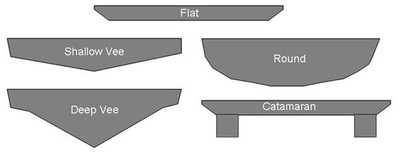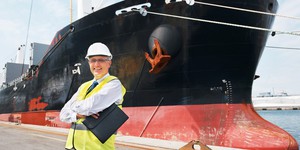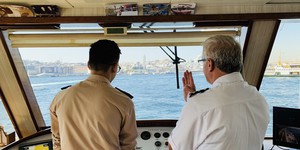Abstract
Who'd have thought that drinking milk can lead to a pretty cool boat? Boat design is an important and active area of engineering. In this science fair project, you will design and build different kinds of model boats out of milk cartons. Examples of the types of designs you might test include a raft, a catamaran, and a V-shaped hull. Once the model boats are built, you will test key features, such as stability, maneuverability, and their ability to glide.Summary
David Whyte, PhD, Science Buddies
This project is based on a DragonflyTV episode.

Objective
The objective of this science fair project is to build and test designs of model boats made out of milk cartons.
Introduction
Boats have a variety of purposes: freighters carry cargo, yachts compete in races, trawlers haul nets through the water to catch fish, just to name a few. These different boat designs depend on their functions-some are built for stability, others for speed. A key feature of a boat's design is the shape of the hull, which is the body of the boat (see Figure 1 below). Flat-bottom boats are simple to build and have a shallow draft (the part of the boat that's under the water). They are not very stable if the weight they are carrying is not carefully balanced. V-bottom boats are able to cut through the water, which results in a smoother ride in rough water. Round-bottom boats move through the water easily, but they also tend to roll over. Catamarans have two separate hulls, which can provide greater stability than mono-hull boats (boats with one hull).
 Image Credit: David Whyte, Science Buddies / Science Buddies
Image Credit: David Whyte, Science Buddies / Science BuddiesA boat with a flat hull has a top and bottom that are parallel, almost like a raft, and is very shallow. Boats with a shallow vee have a hull that tapers on each side and connects at an angle in the center of the bottom of the boat. Boats with a deep vee have a hull with steeper sides that meet at an almost 90 degree angle at the bottom of the boat, it is the deepest boat of the five designs. A round hull boat has a rounded bottom with a cross-section that resembles a half moon rotated on its side. A catamaran has the profile of a flat boat but has two square beams that run across each side of the hull causing the cross-section to look similar to the handle of a briefcase.
Figure 1. Boat hulls come in a variety of shapes.
For this science fair project, you will design and build model boats out of milk cartons and test the different hull designs in a shallow pool or beach. When you are designing the boats, consider which hull designs you think will be best for each test. For example, which type of hull will be the most stable? Which will be the most buoyant?
Terms and Concepts
- Hull design
- Buoyancy
Questions
- Which hull design glides the farthest?
- Which hull design is able to support the most weight?
- Which hull design is the most maneuverable?
Bibliography
- This science fair project was based on this DragonflyTV episode:
TPT. (2006). Milk Carton Boat Race, by Ciara, Brittney and Maria. DragonflyTV, Twin Cities Public Television. Retrieved April 15, 2008. - Nave, C.R. (2008). Buoyancy. Retrieved April 15, 2008.
- NOVA Online. (2000). Buoyancy Basics. Retrieved April 15, 2008.
Materials and Equipment
- Paper milk cartons (the number of cartons will depend on your designs, 1/2-pint cartons will work best)
- Packing tape to tape the cartons together; another option is to glue the cartons together with a hot glue gun
- An adult helper and 2-3 additional helpers
- Lab notebook
- String (1 6-foot length for each boat and several 2- to 3-foot pieces to anchor the bobbers)
- Measuring tape
- Water bottles filled with water (as many as you'd like and different sizes to test how much weight the boats will hold)
- Bobbers; you can find bobbers at large retail stores or any sporting goods store
- Weights, such as fishing weights or screws
Experimental Procedure
To start this experiment, you first need to decide which types of boat hulls you are going to test. Try the ones that are featured in the Dragonfly TV episode, or create your own designs.
- Collect enough milk cartons to build at least three boat designs.
- Assemble the boats using milk cartons and packing tape. Tape the cartons closed so that they won't fill with water. Be sure to attach a string to each boat so you can pull it through the test courses set up in the water.
- Once the boats are assembled, take them to a shallow pool or beach for testing. Bring along an adult who can supervise, and a few helpers to help you test and record data.
- First you will test how each boat glides. You will need some helpers to measure the length of the glide and to record your results in a data table in your lab notebook, like the one below.
- Test how far each boat glides when given a gentle push. To ensure accuracy, make sure you are the one giving the gentle push each time so it is more likely to be the same amount of force. Repeat the test at least two more times, trying to keep each push the same. Have a helper note where the boat stops gliding and measure the length of the glide with the measuring tape.
- Test the stability of each boat by determining how much weight it can carry. One way is to load the boats with water bottles filled with water. Record how much weight each boat was able to carry. Repeat the test at least two more times and record your results.
- Test the maneuverability of each boat. Set up a course for the boats using the bobbers attached to weighted strings, then pull the boats through the course. Try separating the bobbers by 3 feet at first, then experiment with different lengths of separation. Record how often a boat misses a turn or hits a bobber. Also repeat this test at least two more times, making sure you record your results.
-
Look over your results to determine which boat's hull design performed the best in each of your tests.
A sample data table for one trial is shown below. Repeat the tests at least three times with each boat design, and be sure to include units in your results. Which design worked the best for each trial? Which was the best overall?
Hull Design Glide Length Weight Limit Obstacles Hit Other Flat Vee Catamaran Other
Ask an Expert
Global Connections
The United Nations Sustainable Development Goals (UNSDGs) are a blueprint to achieve a better and more sustainable future for all.
Variations
- Try adjusting the hull designs to see how various changes affect their performance. For example, change the angle of the V-shaped hull.
- The goal of testing the boat designs in the video was to see which design would work best as a full-sized boat. If you have lots of milk cartons, and are not afraid of getting wet, build a full-size boat that you can sit on without sinking. How many milk cartons will you need to stay afloat?
Careers
If you like this project, you might enjoy exploring these related careers:
Related Links
- Science Fair Project Guide
- Other Ideas Like This
- Aerodynamics & Hydrodynamics Project Ideas
- My Favorites
- Making It Shipshape: Hull Design and Hydrodynamics
- How Much Weight Can Your Boat Float?









